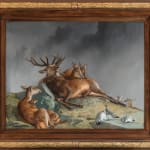Sir Edwin Landseer (1802-1873)
Landseer first visited Scotland in 1824. Impressed by the landscape and the harsh existence of the Highlanders, he returned every autumn to hunt and sketch. Highland subjects, particularly the red deer, became his specialty. Landseer’s engaging personality helped him forge friendships with aristocratic landowners, including Queen Victoria and Prince Albert. The adoption of Scotland by Queen Victoria and Prince Albert lent fresh impetus to Landseer’s art. As their favorite court painter, he was now requisitioned to give expression to their newly-found passion for all things Highland. They were never happier than in Scotland, enjoying sport and other outdoor activities away from the press, beginning their visits in 1842. In 1848, they leased Balmoral Castle, which they later bought and remodeled and which continues to be todays monarch’s home.
Landseer dedicated The Highland Nurses to Florence Nightingale (1820-1910), who arrived in the Crimea with a team of nurses in November 1854, seeing in the maternal actions and sympathies of the hinds, an allusion to Nightingale’s caring for wounded soldiers in unsanitary conditions at Scutari Hospital. In The Highland Nurses, the hinds attend their alpha-male in his moment of crisis, a family group bound together in the unity of the moment. Landseer insisted that the extraordinary event depicted had been witnessed by him, as described in the catalogue for the memorial exhibition: “Sir Edwin, after a day’s stalking, fired a random shot to empty his rifle barrel. At midnight, the keeper called him up, the night being moonlight (sic), to shew (sic) him the incident as painted.”[1] Although Landseer took part in stag hunts, he felt genuine pity for the plight of the deer. The deer in their natural habitat fascinated Landseer, finding inspiration in the tribulations of the stag and his herd amid the chilling mists and precipitous rocks which gave the perfect background to his epic scenes of defiance. In this almost supernatural world the stag is the ethereal lord, the mythical essence of power, embodied in a beast of beauty, grace and courage.
Also fascinated by the plight of the deer -via Landseer- was Walt Disney, whose 1942 animated movie Bambi is now eponymous with the animal. In turn, Bambi inspires contemporary culture as Karen Kilimnik Untitled gives rise to the iconic animal in her typical fashion of an amalgamation of humor and glitz.
[1] Graves, op.cit., p. 32
Provenance
Frederick T. Turner, 8 The Cedars, Clapham Common, 1878
Sir Edward North Buxton, Knighton, Buckhurst Hill, Essex
His sale, Christie’s, 10 March 1916, lot 89
William Sampson and Sons, London
Private collection, Norway
Sale, Sotheby’s, September 18, 2003, lot 41, where acquired by
French & Co., New York
Exhibitions
London, Royal Academy, 1856, no. 208
London, Royal Academy, The Works of the Late Sir Edwin Landseer, R.A., January -14 March 1874, no. 395
London, Grosvenor Gallery, 1890
Paris, Grand Palais, Il était une fois Walt Disney. Aux sources de l’art des studios Disney, 13 September 2006 – 15 January 2007;
Montreal, Musée des Beaux-Arts, 8 March 2007 – 24 June 2007, p. 75.
Munich, Kunsthalle der Hypo-Kulturstiftung, Walt Disneys wunderbare Welt und ihre Wurzeln in der Europäischen Kunst, 19 September 2008 – 25 January 2009, p. 222;
Helsinki, City Art Museum, 25 February – 31 May 2009.
Literature
The Art Journal, 1856, p. 166
Algernon Graves, Catalogue of The Works of the Late Sir Edwin Landseer, R.A., London 1874, no. 395, p. 32
Estelle M. Hurll, Landseer; A Collection of Pictures with Introduction and Interpretation cf.
ENGRAVED
Thomas Landseer, A.R.A., 1858
George Zobel, 1869



